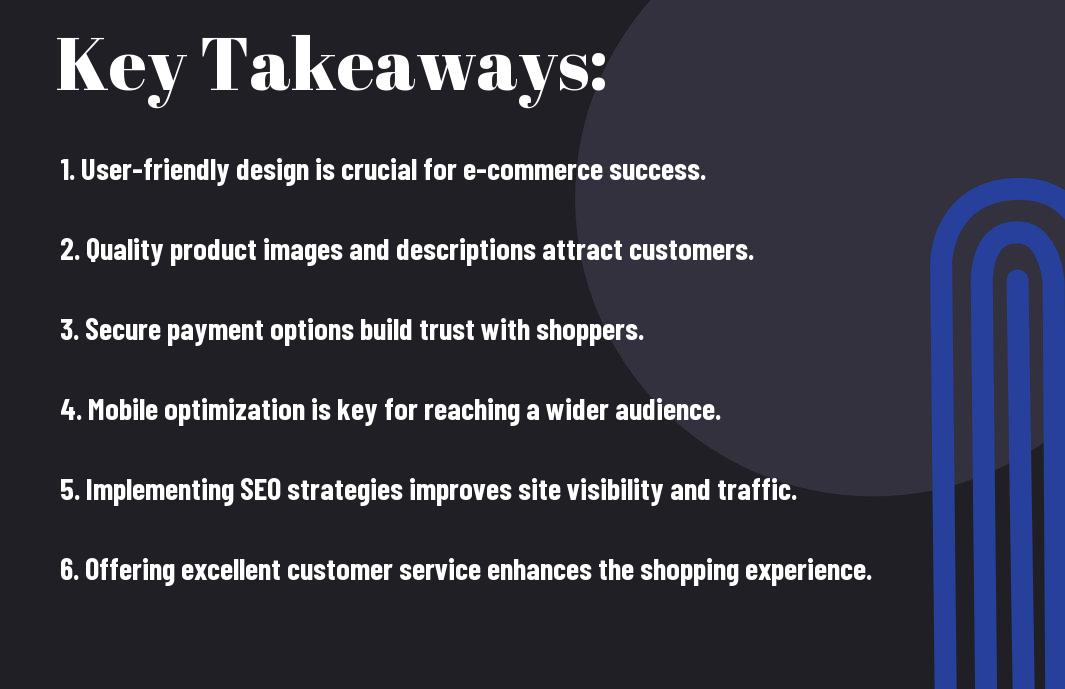Achieving success in the world of e-commerce takes more than just a great product. Your website is the foundation of your online business, and it needs to be optimized for maximum efficiency and user experience. In this blog post, we will guide you through the essential steps to take in order to create a successful e-commerce website. From choosing the right platform to designing a user-friendly interface, we will cover the most important elements that will help you stand out in a crowded online marketplace. Additionally, we’ll outline dangerous mistakes to avoid and highlight the positive details that will help you achieve your e-commerce goals. By the end of this post, you will be equipped with the knowledge and tools necessary to create a thriving e-commerce website.
Key Takeaways:
- Clear Purpose: Defining a clear purpose for your e-commerce website ensures that everything from design to product offerings align with your business goals.
- User-Friendly Design: A user-friendly design is key to attracting and retaining customers. Make sure your website is easy to navigate and find products.
- Mobile-Friendly: With a significant portion of e-commerce traffic coming from mobile devices, it’s crucial to ensure your website is optimized for mobile viewing and purchasing.
- High-Quality Imagery: High-quality product images and videos are essential for showcasing your products and enticing customers to make a purchase.
- Efficient Checkout Process: An efficient and secure checkout process helps decrease cart abandonment and increases the likelihood of completed purchases.

Planning Your E-Commerce Strategy
Some of the most successful e-commerce websites are built on a strategic foundation that takes into account the needs and behaviors of their target audience, as well as the current market trends and competitive landscape. Before diving into the development and design of your e-commerce website, it’s crucial to carefully plan your strategy to ensure its success.
Defining Your Target Audience
When defining your target audience, it’s important to have a clear understanding of who your ideal customers are. This involves creating customer personas and understanding their demographics, behaviors, and needs. By tailoring your e-commerce website to cater to the specific preferences and pain points of your target audience, you can enhance the user experience and increase the likelihood of converting visitors into customers.
Analyzing Market Trends and Competitors
Before launching your e-commerce website, it’s essential to analyze market trends and study your competitors. By keeping a close eye on the latest industry trends, you can identify new opportunities for growth and adapt your strategy accordingly. Additionally, studying your competitors can provide valuable insights into their strengths and weaknesses, allowing you to differentiate your business and stand out in the crowded e-commerce landscape.
Designing Your E-Commerce Website
Despite the increasing competition in the e-commerce industry, a well-designed website can set you apart from the crowd. Your e-commerce website’s design plays a crucial role in attracting and retaining customers. It is the first thing that your potential customers interact with when they visit your website. The design of your e-commerce website should reflect your brand, be user-friendly, and offer a seamless shopping experience.
User-Centric Design Principles
When designing your e-commerce website, it is essential to put yourself in the shoes of your customers. Think about the user experience from the moment they land on your website to the checkout process. Make sure your website is easy to navigate, with intuitive menus and clear call-to-action buttons. Pay attention to visual hierarchy and use high-quality images to showcase your products. Remember, the easier it is for your customers to find what they’re looking for, the more likely they are to make a purchase.
Creating a Responsive and Accessible Website
In today’s digital age, it’s crucial to have a responsive and accessible website. Your e-commerce website should be optimized for all devices, including mobile phones and tablets. With more and more people using their smartphones for online shopping, having a mobile-friendly website is non-negotiable. Additionally, ensure that your website is accessible to all users, including those with disabilities. This means using readable fonts, providing alternative text for images, and designing with accessibility in mind. An accessible and responsive website not only improves the user experience but also helps with your search engine rankings.
Building Your E-Commerce Platform
Your e-commerce platform is the foundation of your online store, and it is essential to choose the right platform to ensure the success of your business. To learn more about building a successful e-commerce website, you can check out this guide on How to make a successful e-commerce website. It provides valuable insights and best practices for creating and managing an effective e-commerce platform.
Choosing the Right E-Commerce Software
When selecting e-commerce software, it’s crucial to consider factors such as scalability, customization options, and integration capabilities. Look for a platform that can support your business as it grows, and offers user-friendly interface for smooth management. Additionally, it should integrate seamlessly with third-party tools and webservices that you may want to use to enhance your store’s functionality.
Payment Gateways and Security Measures
Payment security is non-negotiable when it comes to e-commerce. Choosing a reliable payment gateway and Implementing SSL encryption on your website is essential to protect your customers’ sensitive information. You should only opt for trusted payment gateways that prioritize security and comply with industry standards to prevent fraudulent activities and provide a sense of security for your customers.
Marketing Your E-Commerce Site
Unlike a physical store, simply setting up an e-commerce website is not enough to attract and retain customers. Marketing your e-commerce site is essential for driving traffic, increasing sales, and building brand awareness. Whether you’re just starting out or looking to enhance your current marketing efforts, here are some key strategies to consider.
SEO Best Practices for E-Commerce
To improve your e-commerce website’s visibility and attract organic traffic, implementing strong SEO practices is vital. By optimizing your product descriptions, meta titles, and headers with relevant keywords, you can enhance your site’s search engine ranking. Additionally, creating quality content, building backlinks, and ensuring a seamless user experience on your site can further boost your SEO efforts.
Leveraging Social Media and Email Marketing
Social media and email marketing are powerful tools for promoting your e-commerce business. By engaging with your audience on popular platforms like Facebook, Instagram, and Twitter, you can build a loyal following and drive traffic to your website. Additionally, utilizing email marketing to send personalized offers, product updates, and newsletters can help you nurture customer relationships and encourage repeat purchases.

Managing Your Online Store
To create a successful e-commerce website, managing your online store is crucial. You need to effectively handle inventory, order fulfillment, customer service, and engagement strategies to ensure a seamless shopping experience for your customers. This chapter will guide you through the key aspects of managing your online store to drive sales and build customer loyalty.
Inventory and Order Fulfillment
To run a successful e-commerce website, you must have a handle on your inventory and order fulfillment processes. Your inventory management system should be accurate and updated in real-time to prevent overselling or running out of stock. Effective order fulfillment is crucial for providing a positive customer experience. Your ability to process and ship orders efficiently can greatly impact customer satisfaction and retention. Consider implementing an automated order management system to streamline the process and reduce human error. Additionally, having a reliable shipping and delivery partner is essential for timely and hassle-free order fulfillment. Ensuring accuracy and efficiency in your inventory and order fulfillment processes is crucial to avoid disappointing your customers.
Customer Service and Engagement Strategies
Customer service is the backbone of any successful e-commerce business. Your ability to respond promptly to customer inquiries, address concerns, and provide assistance can greatly impact customer satisfaction and repeat business. Implementing live chat support, a responsive customer service team, and clear communication channels can help build trust and loyalty with your customers. Moreover, engagement strategies such as personalized marketing, loyalty programs, and referral incentives can help you connect with your customers on a deeper level and encourage repeat purchases. Investing in exceptional customer service and implementing engaging strategies can set your e-commerce website apart from the competition and foster long-term customer relationships.
Measuring Success and Scaling Up
Now that your e-commerce website is up and running, it’s time to focus on measuring its success and scaling up your business. This involves setting up analytics and KPIs to track your progress, as well as implementing strategies for growth and expansion. To get a comprehensive guide on how to start an e-commerce business, you can refer to this How To Start an Ecommerce Business: Guide for 2024.
Setting Up Analytics and KPIs
Setting up analytics and Key Performance Indicators (KPIs) is crucial for understanding how well your e-commerce website is performing. By tracking data such as website traffic, conversion rates, and customer demographics, you can gain valuable insights into the effectiveness of your marketing strategies and the overall user experience. You can use tools like Google Analytics or other e-commerce platforms to set up and monitor your KPIs, ensuring that you have a clear understanding of your business’s performance at all times.
Strategies for Growth and Expansion
Once you have established a solid foundation for your e-commerce business, it’s time to focus on strategies for growth and expansion. This could involve expanding your product range, entering new markets, or implementing new marketing initiatives. It’s essential to have a clear plan in place for scaling up your business, while also identifying and mitigating any potential risks. By continuously innovating and adapting to the changing market landscape, you can position your e-commerce website for sustained growth and success.
Conclusion: How to Create a Successful E-Commerce Website
Hence, creating a successful e-commerce website involves a strategic combination of user-friendly design, seamless navigation, compelling content, and secure payment options. By prioritizing the user experience, optimizing your website for mobile devices, and utilizing effective marketing strategies, you can attract and retain customers while driving sales. Additionally, leveraging analytics tools to track and improve performance, as well as staying updated on industry trends and technological advancements, will further enhance the success of your e-commerce venture. Ultimately, by implementing these best practices and continuously refining your approach, you can create an e-commerce website that not only meets but exceeds your goals and expectations.
FAQ
Q: What are the key components of a successful e-commerce website?
A: The key components of a successful e-commerce website include user-friendly design, seamless navigation, secure payment gateways, high-quality product images and descriptions, and efficient customer support.
Q: How important is responsive design for an e-commerce website?
A: Responsive design is crucial for an e-commerce website as it ensures a seamless user experience across all devices, including desktops, laptops, tablets, and mobile phones. A responsive website also impacts SEO rankings and increases customer satisfaction.
Q: What are the best practices for optimizing a website for search engines?
A: To optimize an e-commerce website for search engines, it’s essential to conduct keyword research, optimize product descriptions and meta tags, utilize internal linking, create high-quality content, and focus on site speed and mobile-friendliness. Additionally, implementing a solid backlink strategy is important for higher search engine visibility.
Q: How can a successful e-commerce website enhance customer trust and loyalty?
A: Building customer trust and loyalty involves showcasing secure payment methods, including customer reviews and testimonials, offering a transparent return and refund policy, providing exceptional customer service, and ensuring a seamless and secure checkout process.
Q: What are some effective marketing strategies to drive traffic to an e-commerce website?
A: Effective marketing strategies for e-commerce websites include utilizing social media advertising, email marketing campaigns, influencer partnerships, content marketing, search engine advertising, and offering promotions and discounts. It’s important to analyze and measure the success of these strategies to continually optimize marketing efforts.



